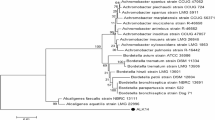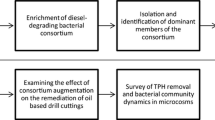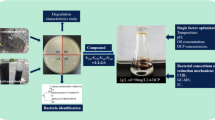Abstract
The microorganisms Bacillus circulans NSh, B. firmus OBR 1.1, B. firmus OBR 3.1, Solibacillus silvestris OBR 3.2, B. circulans OBR 3.3, Halomonas sp. OBR 1, and Erwinia rhapontici OBR 4.1, isolated from drill cuttings, were shown to be able to degrade oil, mineral oil, and diesel fuel. The B. circulans NSh and B. firmus OBR 1.1 bacteria were shown to degrade 62 and 32% of oil, respectively, in an alkaline medium (pH 9) after 14 days and 42 and 22% of oil, respectively, in a saline medium (10% NaCl). Under conditions of increased ambient salinity and alkalinity, the B. circulans NSh and S. silvestris OBR 3.2 bacteria were shown efficiently to degrade petroleum hydrocarbons not only individually, but also in combination with the oil-oxidizing Dietzia maris AM3 microorganism. The efficiency of oil degradation by the consortium composed of B. circulans NSh D. maris AM3 was higher than that by monocultures.



Similar content being viewed by others
REFERENCES
Abalakov, D.A., Polovkin, V.P., and Vakhromeev, A.G., Geoekologiya kustovogo bezambarnogo bureniya neftegazovykh mestorozhdenii (Geoecology of Cluster Pitless Drilling at Oil and Gas Fields), Irkutsk: Art-Press, 2003.
Andreeva, I.S., Emel’yanova, I.K., and Zagrebel’nyi, S.N., Psychrotolerant oil-destructing strains for bioremediation of soil and water, Biotekhnologiya, 2006, no. 1, pp. 46–48.
Astrova, N.G., Moiseeva, L.V., and Astrov, V.V., Development of bioconversion treatment of oily wastewater by the Cascade Star system, in Materialy mezhdunarodnoi nauchno-prakticheskoi konferentsii “Voda i zdorov’e-98” (Proc. Int. Sci.-Pract. Conf. “Water and Health-98”), Odessa: Odes. Gos. Univ., 1998, pp. 213–217.
Balaba, V.I., Ensuring environmental safety of construction of wells in the sea, Burenie Neft’, 2004, no. 1, pp. 18–21.
Belyakov, A.Yu. and Pleshakova, E.V., Screening of microorganisms destructing components of drilling fluids, Izv. Sarat. Univ. Nov. Ser., Ser. Khim. Biol. Ekol., 2013, vol. 13, no. 4, pp. 37–43.
Belyakov, A.Yu., Pleshakova, E.V., and Amangalieva, V.A., Ecological and functional features of bacteria isolated from drill cuttings, Izv. Samar. Nauch. Tsentra Ross. Akad. Nauk, 2014, vol. 16, no. 1, pp. 294–298.
Bulatov, A.I., Makarenko, P.P., and Proselkov, Yu.M., Burovye promyvochnye i tamponazhnye rastvory: ucheb. posobie dlya vuzov (Drilling Washings and Cement Slurries: A Manual for Universities), Moscow: Nedra, 1999.
Cunningham, C.J. and Philp, J.C., Comparison of bioaugmentation and biostimulation in ex situ treatment of diesel-contaminated soil, Contam. Reclam., 2000, vol. 8, no. 4, pp. 261–269.
Drugov, Yu.S. and Rodin, A.A., Ekologicheskie analizy pri razlivakh nefti i nefteproduktov, prakticheskoe rukovodstvo (Environmental Analyzes for Oil Spills and Oil Products: A Practical Guide), Moscow: BINOM, Laboratoriya Znanii, 2007.
Gerasimova, M.S., Selection of technology for disposal and recycling of waste drilling muds, in Materialy II mezhdunarodnoi nauchnoi studencheskoi konferentsii “Okhrana okruzhayushchei sredy i ekologiya” (Proc. II Int. Sci. Student Conf. “Environmental Protection and Ecology”), Stavropol: Sev.-Kavkaz. Gos. Tekhn. Univ., 2008, p. 180.
Heath, D.J., Lewis, C.A., and Rowland, S.J., The use of high temperature gas chromatography to study the biodegradation of high molecular weight hydrocarbons, Org. Geochem., 1997, vol. 26, no. 12, pp. 769–785.
Hickenbottom, K.L., Hancock, N.T., Hutchings, N.R., Appleton, E.W., Beaudry, E.G., Xu, P., and Cath, T.Y., Forward osmosis treatment of drilling mud and fracturing wastewater from oil and gas operations, Desalination, 2013, vol. 312, pp. 60–66.
Ilyina A., Castillo Sanchez, M.I., Villarreal Sanchez, J.A., Ramirez Esquivel, G., and Candelas Ramirez, J., Isolation of soil bacteria for bioremediation of hydrocarbon contamination, Vestn. Mosk. Gos. Univ, Ser. 2: Khim., 2003, vol. 44, no. 1, pp. 88–91.
Islamov, Kh.M., Geoecological safety of chemicals for treatment of drilling fluids, Geol. Geogr. Glob. Ekol., 2011, no. 3, pp. 174–179.
Ivanenko, N.V., Ekologicheskaya toksikologiya: uchebnoe posobie (Environmental Toxicology: A Textbook), Vladivostok: Vladivost. Gos. Univ. Ekonom. Servisa, 2006.
Jerry, M., Estimation of bioavailability of metals from drilling mud barite, Integr. Environ. Assess. Manage., 2008, vol. 4, no. 2, pp. 184–193.
Karaulov, A.K. and Khudolii, N.N., Avtomobil’nye masla. Motornye i transmissionnye. Assortiment i primenenie (Car Oils (Motor and Transmission): The Range and Application), Kursk: Raduga, 2000.
Khaustova, A.P. and Redina, M.M., Okhrana okruzhayushchei sredy pri dobyche nefti (Environmental Protection in Oil Production), Moscow: Delo, 2006.
Khodja, M., Khodja-Saber, M., Canselier, J.P., Cohaut, N., and Bergaya, F., Drilling fluid technology: performances and environmental considerations, in Products and Services; From R&D to Final Solutions, Fuerstner, I., Ed., Rijeka: InTech, 2010, pp. 227–256.
Khudorkomov, A.A., Karaseva, E.V., Samkov, A.A., Volchenko, N.N., and Kozitsyn, A.E., Destruction of hydrocarbons by different morphotypes of oil-oxidizing actinobacteria, Nauch. Zh. Kuban. Gos. Agrarn. Univ. [electronic resource], 2013, no. 92 (8). http://ej.kubagro.ru/2013/08/ pdf/51.pdf . Accessed August 2, 2016.
Loginov, O.N., Nurtdinova, L.A., Boiko, T.F., Chetverikov, S.L., and Silishchev, H.N., Evaluating the effectiveness of the new biological product Lenoyl for the remediation of oil-contaminated soils, Biotekhnologiya, 2004, no. 1, pp. 77–82.
Miller, J., Experiments in Molecular Genetics, New York: Cold Spring Harbor, 1972.
Morozov, V.I., Fedorov, A.V., and Geisherik, G.M., Environmental problems of the development of the oil and gas potential of Eastern Siberia and the Far East, Miner. Resur. Rossii. Ekon. Upr., 2004, no. 1, pp. 64–73.
Pleshakova, E.V., Dubrovskaya, E.V., and Turkovskaya, O.V., Efficiencies of introduction of an oil-oxidizing Dietzia maris strain and stimulation of natural microbial communities in remediation of polluted soil, Appl. Biochem. Microbiol., 2008, vol. 44, no. 4, pp. 389–395.
Ryazanov, Ya.A., Entsiklopediya po burovym rastvoram (Encyclopedia of Drilling Muds), Orenburg: Letopis’, 2005.
Shukla, O.P., Biodegradation for environmental management, Everyman’s Sci., 1990, vol. 25, no. 2, pp. 46–50.
Soprunova, O.B., Gal’perina, A.R., and Klyuyanova, M.A., Means for degradation of petroleum hydrocarbons in a medium containing NaCl to 24.0%, RF Patent no. 2422505, 2011, Byull. no. 18.
Surzhko, L.F., Finkel’shtein, Z.I., and Baskunov, B.P., Utilization of oil in soil and water by microbial cells, Mikrobiologiya, 1995, vol. 64, no. 3, pp. 393–399.
Tazetdinova, D.I., Antonov, V.V., Gazizov, I.S., and Alimova, F.K., The enzymatic activity of leached chernozems of East Trans-Kama, Volga–Kama steppe, at synergetic pollution with heavy metals and hydrocarbons, Fundam. Issled., 2013, no. 8–2, pp. 364–369.
Terekhova, V.A., Safety testing of artificial soils from organic wastes, Ekol. Proizv., 2010, no. 2, pp. 56–60.
Wenderoth, D.F., Rosenbrock, P., Abraham, W.-R., Pieper, D.H., and Hofle, M.G., Bacterial community dynamics during biostimulation and bioaugmentation experiments aiming at chlorobenzene degradation in groundwater, Microb. Ecol., 2003, vol. 46, no. 2, pp. 161–176.
Yagafarova, G.G., Mavlyutov, M.R., and Barakhnina, V.B., Biotechnological method of disposal of oil sludge and drilling waste, Gorn. Vestn., 1998, no. 4, pp. 43–46.
Zanaroli, G., Toro, S.D., Todaro, D., Varese, G.C., Bertolotto, A., and Fava, F., Characterization of two diesel fuel degrading microbial consortia enriched from a non acclimated, complex source of microorganisms, Microb. Cell Fact., 2010, vol. 9, no. 10, pp. 35–38.
Author information
Authors and Affiliations
Corresponding author
Additional information
Translated by A. Panyushkina
Rights and permissions
About this article
Cite this article
Pleshakova, Y.V., Belyakov, A.Y. & Deev, D.V. Characteristics of Hydrocarbon Degradation by Bacteria Isolated from Drill Cuttings. Biol Bull Russ Acad Sci 45, 1174–1181 (2018). https://doi.org/10.1134/S1062359018100229
Received:
Published:
Issue Date:
DOI: https://doi.org/10.1134/S1062359018100229




